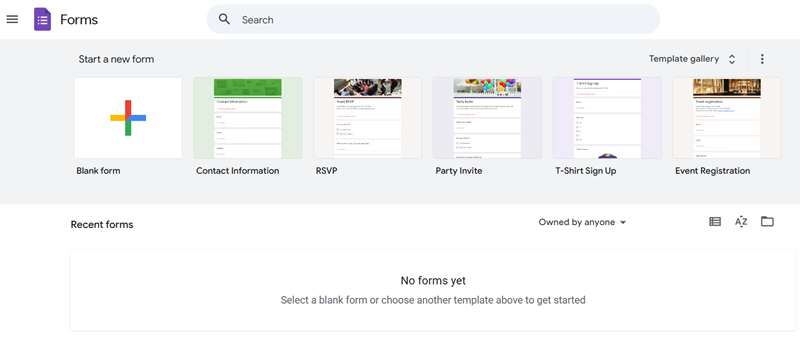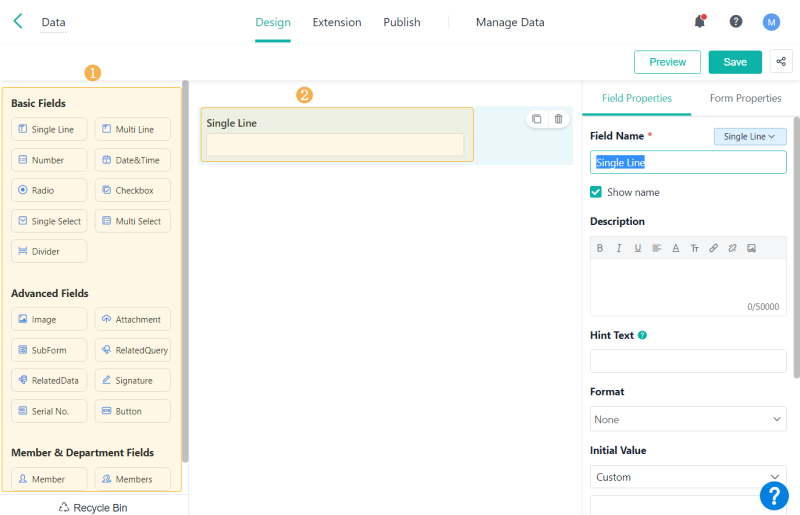If you’ve been looking for the best form builder in 2024, you’ve probably come across the name Google Forms more than once. This widely praised online form tool is popular for its simplicity and ease of use. It works especially well for individuals, small companies, or educators who need to create straightforward surveys and quick polls. However, like any tool, Google Forms isn’t suitable for everyone, especially if you need conditional logic to guide participants through questions based on their responses.
To prevent the scenario where you discover mid-creation that Google Forms doesn’t meet your specific needs, it’s wise to read this Google Forms review before you start crafting your form. In this article, we’ll evaluate Google Forms from its top five benefits and drawbacks to a comparison of it with similar tools. Now let’s get going!

Google Forms: The Most Popular Form Builder
Google Forms is an online tool designed to create basic forms with simple questions, such as surveys, quizzes, and simple registration forms. It is a great helper for novices and non-technical users due to its straightforward and clear interface, and 100% free. As such, Google Forms is a widely used form-creation platform.
Google Forms offers 11 basic fields and 17 pre-designed templates. These options typically meet users seeking to collect opinions, feedback, and data in common work and educational tasks. Additionally, Google Forms supports 3 different form distribution methods, allowing users to easily share and collect responses via email, direct link, or by embedding the form on a website.
👍You May Also Like:
Best Form Builders with Multiple Features: Worth A Try
Best Survey Tools for Feedback, Research, and Poll
Advantages of Google Forms
Used by a lot of users, Google Forms is popular for some reason. So we’ll look at some of the key advantages that set Google Forms apart from other form builders.

Unlimited Forms and Responses
Similar to other online free form builders, Google Forms allows users to create an unlimited number of forms. Also, by default, it has no restriction on the number of submissions. To stop accepting responses, the tool requires manually closing the form. While this may require an extra step, it is an excellent option for those who need to gather large amounts of data. Besides, Google Forms offers 11 question types, such as short answer, paragraph, multiple choice, checkboxes, dropdowns, and date fields, which are all common and practical options for both work and study.
What’s even better is that Google Forms provides 17 templates to help new users avoid starting from scratch. These templates include Order Form, Event Registration, Event Feedback, and Contact Information, covering various needs in personal life, work, and education.
Simple Conditional Logic
As a completely free form builder, Google Forms only provides basic skip logic, that is, the form will direct respondents to different subsequent questions based on their answers. This conditional logic can apply only to questions with dropdowns and multiple-choice options. The benefits of this feature are to make the form more dynamic and flexible and to help users get more targeted responses.
Reporting and Data Analytics
After collecting responses, Google Forms can generate a pie or bar chart report for the user with response data updates. These charts allow users to quickly grasp the overall trends and insights from the responses.
While Google Forms may lack in-depth data analysis and extensive reporting features offered by other forms, such as Jodoo Form Builder, which provides a variety of data visualization charts, it is more than adequate if you just want to create simple forms focused on information gathering.
Integration with Google Services
Unlike other form builders – WuFoo and Paperform – that focuses more on deep integration with third-party software, Google Forms offers higher compatibility with its own suite of Google services such as Google Sheets and Google Drive. For example, responses will be automatically stored in Google Sheets and updated in real time.
Besides, you can open the raw data with Google Sheets for more in-depth analysis. Moreover, upon finishing, forms can be easily shared with others via Google Drive. These convenient integrations greatly improve workflow efficiency for those already using Google Workspace.
Simple Interface
Google Forms features a clean and intuitive interface. Even users with less technical skills can easily get started. With just a few clicks, users can add questions, set question types, insert images, and change themes to create and edit forms. Moreover, sharing forms with Google Forms is incredibly convenient and versatile. You can choose to send them via an email, a link, or an embedded website.
Disadvantages of Google Forms
While Google Forms has many advantages, its limitations may pose specific challenges for some users. To help you gain a more comprehensive understanding of Google Forms, we’ll also explore its shortcomings in detail and discuss how these limitations might impact users. Also, be sure to check Top Alternatives to Google Forms for Advanced Features and Customization if you need them.

Few Field Types, Logic, and Templates
As mentioned earlier, the field types of Google Forms are relatively basic, lacking some advanced or dynamic options like electronic signatures, dynamic dropdown menus, or calculated fields. The same goes for its conditional logic.
Google Forms lacks advanced conditional logic options such as advanced branching logic, dynamic question display, multi-conditional logic, and so on. These limitations make Google Forms less suitable for complex surveys or forms where advanced conditional logic is necessary to create a streamlined, user-friendly experience.
Additionally, the templates offered by Google Forms are very limited. It only provides basic pre-made templates like event registration, job application, and order forms. Compared to other form builders like Jodoo and 123FormBuilder, it lacks industry-specific templates.
👍 Alternatives for Form Building:
For users who need more advanced and flexible form-building capabilities but don’t want to spend money, take advantage of premium form builders’ free plans. Jodoo Form Builder, for instance, offers 20+ field types and nearly a hundred templates, along with robust conditional logic and data visualisation features. All these are free to use.
Limits on Upload Files
While Google Forms allows users to upload files, their size is restricted. Text files can only be 500 KB and images be 2MB. This constraint may be insufficient for businesses in industries like real estate or construction, which require uploading large property documents, blueprints, or high-resolution property images, or educational institutions or research organizations that need to collect sizable research papers or data files from students or participants.
No Payment Gateways
Google Forms does not integrate with payment platforms like PayPal. This means that if small businesses, freelancers, or organizations need to collect orders and process payments online, Google Forms might let you down.
Basic Design Customization Options
Google Forms offers some basic theme customization options, such as a few text style choices, font sizes, and background color changes. However, it falls short in terms of more sophisticated customization capabilities. Users cannot modify the layout and styling of the form, incorporate custom CSS, or add animations and transitions. Consequently, the forms may not be as visually engaging or may not match your brand’s style.
Lack of Robust Data Analytics Tools
While Google Forms can generate basic chart reports to convey some essential information, it can’t help users who require more in-depth data analysis, as it lacks advanced data filtering and visualization tools. To conduct further analysis, you would need to export the data to Google Sheets or other software.
Therefore, if you’re looking for a tool that offers advanced data analysis features directly within the form-building process, make sure to check its data analytics tools.
💡 Read More:
How to Create A Simple Form in 5 Minutes
How to Create A Survey with Multiple Questions (Different Ways)
Build Online Forms Easily on Google Forms
Creating a form on Google Forms is very straightforward. Let’s take creating a survey as an example and see how it works.
STEP 1: Navigate to Google Forms and sign in with your Google account. Start the survey creation process by selecting the “Blank form” option in the top-left corner.

STEP 2: The page will then jump to the form editor. Click on the “Untitled form” section at the top to name your survey. You can also add a short description below your title.

STEP 3: Type out your questions in the “Untitled Question” box and use the dropdown menu to select the type of question (e.g., multiple-choice, checkboxes, short answers). Post selection, fill in the necessary options on the left.
To make your survey visually appealing, click the “Palette” icon to choose colors, background images, and fonts that fit your survey’s theme.

STEP 4: Before sharing, use the “Eye” button to preview your survey and ensure everything looks and functions as intended.
STEP 5: With your survey ready, hit the “Send” button to share it. You can opt to send it by email, share a link, or embed it on a webpage.

Pricing: 100% Free
Google Forms is indeed offered at no cost, with no subscription fees or additional charges. It represents an excellent choice for those who are new to form creation or are working with a restricted budget. Nevertheless, it’s crucial to remember that access to this tool requires having a Google account.
Competition: Google Forms and 3 Popular Form Builders
As a free form builder, Google Forms performs reasonably well overall. However, there are also many other popular form builders on the market. Curious to see how Google Forms stacks up against them? This section has you covered. The table below compares Google Forms with three popular tools—SurveyMonkey, Jotform, and Jodoo—so you can gain a clearer and more comprehensive understanding of their unique features.
| Form Builder | Conditional logic | Data visualization | Integration | Pricing | |
|---|---|---|---|---|---|
| Google Forms | 11 field types17 basic templates | Basic skip logic | Bar charts, pie charts | Integrated with Google Workspace | 100% free |
| SurveyMonkey | 14 field types400+ survey templates | Various logic features (page skip logic, advanced branching, page randomization, etc.) | Customizable charts, graphs, grids, and more. Analytics tools with detailed cross-tabulations and filtering options. | Integrated with 100+ apps | Free plan available Paid plan: monthly starting price $34 (billed annually) |
| Jotform | 30+ field types10,000 ready-made templates for all industries | 6 conditional logic (show/hide field, update/calculate field, hide a page, etc.) | Customizable charts, graphs, grids, and more. Useful analytics tool to view form submission states, and check conversion rates. | Integrated with nearly 300 apps | Free plan available Paid plan: monthly starting price $19.5 (billed annually) |
| Jodoo Form Builder | 20+ field types Nearly 100 free templates for 60+ use cases | Robust logic features (skip questions, show/hide specific questions based on user responses, etc.) | Various dashboard views and statistical charts Powerful data analysis tools for real-time analysis | Open platform with API/Webhook/SSO/Front-End Event integration | Free plan available Paid plan: monthly starting price $12 (billed annually) |
Google Forms: Suitable for Basic Data Collection
As shown in the table above, the free tool Google Forms is suited for simple forms that require collecting large amounts of data, such as surveys, questionnaires, and quizzes. If you need to create more complex and flexible forms, Google Forms may not meet those needs.
✅ More to Explore:
Comprehensive Review gf Jotform: Features, Pros, and Cons
Best Forms Automation: Software to Make Form Creation Easier & Faster
Feature-rich Alternative: Jodoo Form Builder
Based on the overview above, some of you may find that Google Forms doesn’t meet your needs. Consider shifting your focus to the feature-rich yet cost-effective alternative, Jodoo Form Builder. It is renowned for its feature-full free version and decently priced paid plans.
The free plan offers many advanced features that other tools might charge for, such as dashboard analytics and complex data presentation, as well as automated workflow for repetitive tasks. You can start with its free tier. If you find it helpful, you can consider subscribing to its premium plan which starts at $12 per user per month! For more details, check our post: Jodoo Form Builder Review: What Makes It Stand Out
Why Choose Jodoo over Google Forms

Jodoo Form Builder excels in several areas compared to Google Forms, offering a range of standout features:
- Free unlimited forms with up to 500 fields supported per form.
- Over 20 field types ranging from basic to advanced ones.
- Up to 1,000 form submissions per month with the free plan and unlimited in paid plans.
- Nearly 100 free, ready-to-use templates covering various industries and use cases.
- Multi-step processes and nested logic for more complex form behaviors.
- Visual charts in the dashboard for easy analysis and presentation of complex data.
Jodoo: Efficient Form Builder for Individuals and Businesses
While Google Forms is ideal for creating simple forms for collecting basic information, Jodoo Form Builder supports a much broader range of applications. It can handle everything from surveys and quizzes to employee onboarding, registration, appointment requests, and product orders. Whether you’re a newcomer or a team looking to enhance efficiency, Jodoo Form Builder is designed to meet both basic and advanced needs.
Final Verdict
Google Forms is a free form builder provided by Google, and in 2016, it was integrated with Google Workspace. Google Forms offers 8 basic field types, unlimited forms, and unlimited submissions. However, this free tool is too basic to create complex forms. If you need conditional questions, advanced quizzes, and data analysis, Google Forms is not a smart choice. But if you just need forms to collect large amounts of data from various sources, Google Forms is still worth a shot.


